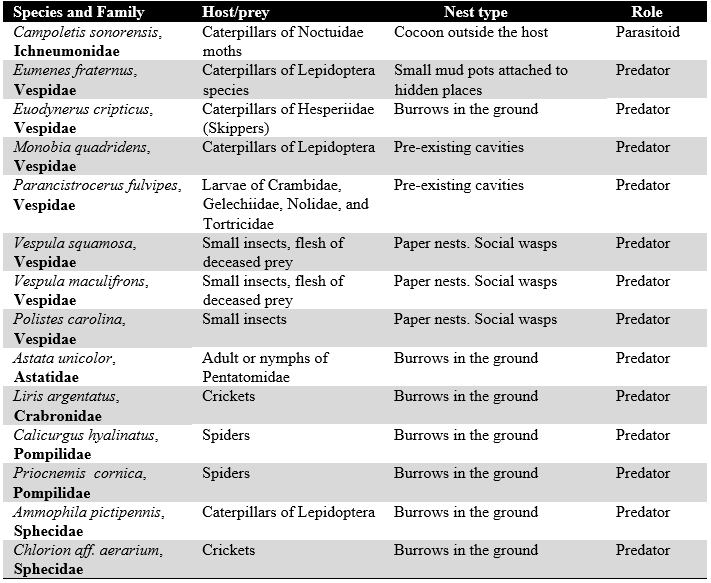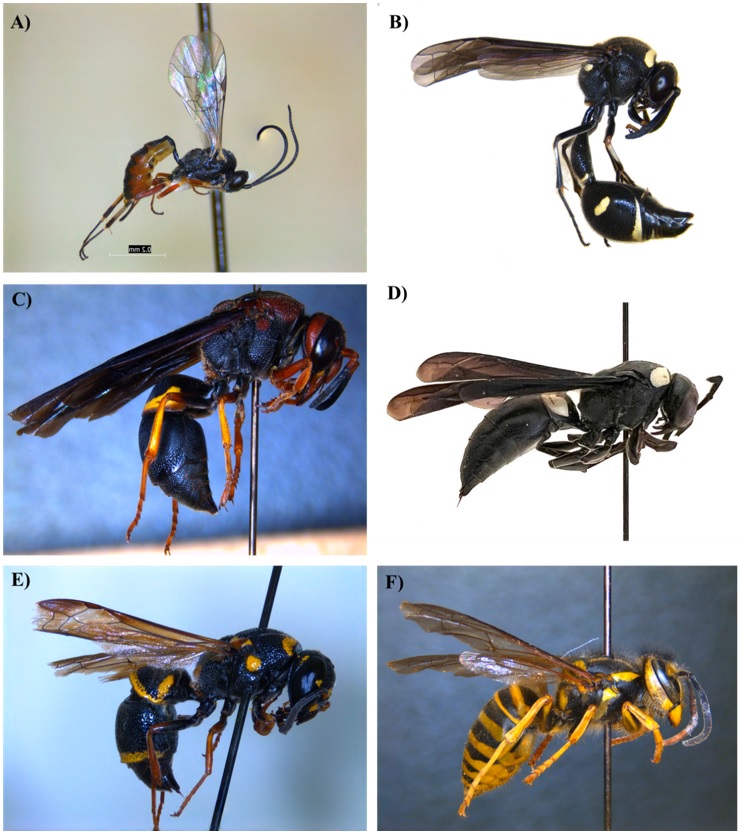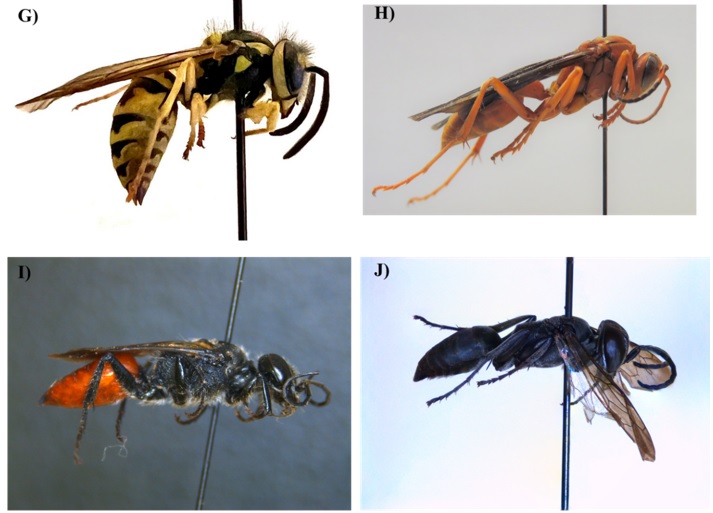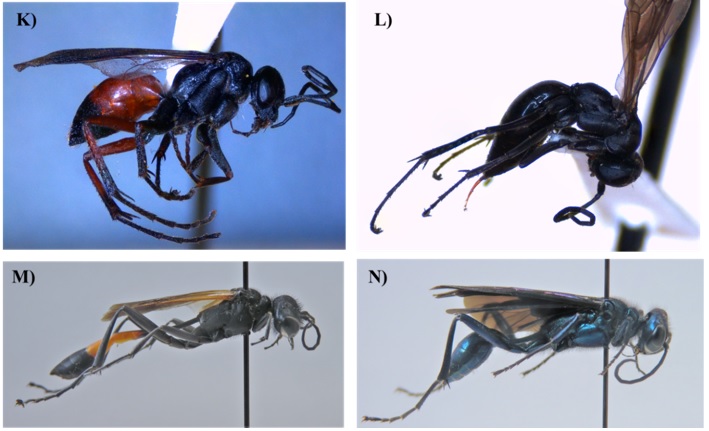Wasp Species Found in Hemp
ENTFACT-160: Wasp Species Found in Hemp - A Survey in Western Kentucky | Download PDF
Armando Falcon-Brindis, Research Analyst and Raul T. Villanueva, Extension Specialist
An Overview of The Wasp World
Research has shown that wasps are beneficial insects in agricultural systems. They are important agents of biocontrol, reducing economic losses caused by pests across agroecosystems (LaSalle & Gauld, 1993). Wasps belong to the Order Hymenoptera, which includes ants, bees, and sawflies, but the group of wasps is of the most species rich. These insects are more than just hornets and yellowjackets, the most well-known wasps. In fact, the majority of wasp species are solitary that rarely sting people rather than living in paper nest colonies with queens and attacking whoever threatens their nests.
Wasps occur in almost every environment. They are ubiquitous and ecologically important. Besides bees, wasps are also essential pollinators in some systems and several minute wasp species are key to controlling pests, even more efficiently than chemical control. Wasps are part of our natural pest control army that help to protect plants from undesired insects and to pollinate them to ensure fruit production. They have extremely diversified feeding, nesting, and complex behavioral habits, thus providing important ecological services as predators and parasitoids. These insects are of great importance to our world. Natural or human modified ecosystems would collapse without the immense diversity of wasps (≈ 160,000 described species).
A Quick Assessment of Wasps in Hemp Grown in KY
Hemp growing systems may be an excellent example of wasp biocontrol, but there is very little information available. In Kentucky, hemp farmers are only allowed to use biological-based products such as bacteria, viruses, and plant extracts, or the release of natural enemies, the latter usually for enclosed environment hemp production. Nonetheless, nothing is known about the wasps preying on and parasitizing hemp pests (e.g., moth caterpillars, stink bugs, aphids) in traditional growing systems. As a first approach to learning more about the wasps in hemp systems, scouting was conducted using sweep net between September and October 2021 in experimental and commercial CBD hemp fields in western Kentucky. Sampling effort was based on the presence of wasps visiting or patrolling hemp fields during both vegetative and flowering stages. The wasps patrolling the hemp plots were collected and taken to the laboratory for identification. Since wasps also depend on nectar sources, wasps captured in this report might be exploring hemp fields for this resource and for available prey. Wasps respond to habitat quality; thus, the presence and abundance of surrounding weeds may attract some individuals to hemp.
A Glimpse of Our Allied Wasps in Hemp
In this short study, 14 wasp species from six different families (Table 1) were found. Thirteen were predatory species, and only one species was a parasitoid. The family Vespidae represented 50% of the captured species. This group includes highly social wasps. The survey did not find these wasps with their prey; however, previous biological information allows us to know their diet (LaSalle & Gauld, 1993). On the wasps collected here, there were both generalist and specialist feeders. Diets include different arthropods: moth larvae, butterfly larvae, stink bugs, crickets, and spiders (Figures 1a (A to F) and 1b (G to N) show the images of the 14 species captured in this study).
Among the main barriers to understand wasps are the lack of knowledge, and fallacies regarding their aggressive behavior. However, the public should perceive these insects in a different way, rather than being aggressive the focus should be on the importance to prey on some pests. This study shows that hemp grown outdoors receives the visit of several wasp species. These wasps potentially provide services removing some pests from hemp fields. Further studies with expanded sampling on hemp grown for CBD, seed, or fiber will provide additional information on the diversity of species, including other parasitoids of caterpillars. Appreciation of this insect group can improve with more research and information, as well as grower education about the important role these insects play in pest control and pollination. Future studies should use, sentinel eggs to evaluate wasp predation, and other types of collecting wasps to evaluate their diversity.
Table 1. List of wasp species recorded on hemp grown outdoors in Caldwell Co., Kentucky.


Figure 1a. Wasps found in hemp fields in hemp in western KY in 2021. A) Campoletis sonorensis, B) Eumenes fraternus, C) Euodynerus cripticus, D) Monobia quadridens, E) Parancistrocerus fulvipes, F) Vespula squamosa. Pictures and wasp ID: A. Falcon-Brindis, UK Research and Education Center, Princeton, KY.

Figure 1b. Wasps found in hemp fields in western KY in 2021. G) Vespula maculifrons, H) Polistes carolina, I) Astata unicolor, J) Liris argentatus, K) Calicurgus hyalinatus, L) Priocnemis cornice, M) Ammophila pictipennis, N) Chlorion aff. aerarium.
Issued: 5/22
CAUTION! Pesticide recommendations in this publication are registered for use in Kentucky, USA ONLY! The use of some products may not be legal in your state or country. Please check with your local county agent or regulatory official before using any pesticide mentioned in this publication.
Of course, ALWAYS READ AND FOLLOW LABEL DIRECTIONS FOR SAFE USE OF ANY PESTICIDE!

